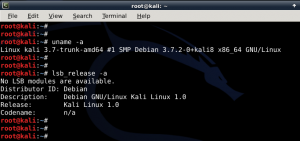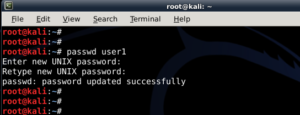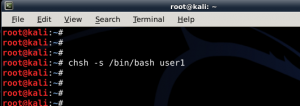This guide will walk you through on how to add remove user (standard user or non-root user) in Kali Linux. I’ve tested this in Kali Linux, so any Debian or Debian derivative (such as Ubuntu) should just work.
Table of Contents
This guide accomplishes:
The main reason I wanted to try this to demonstrate the followings:
- Add a user with all user directories already in place (thereby avoiding “Could not update .ICEauthority var/lib/gdm3/.ICEauthority” or any error containing .ICEauthority or permission in general.
- Add user to sudo group to allow him to use root commands. You can also add user to ‘lpadmin’ group to allow printing for Canon or HP and such. See Linux printing guide
- Change default shell from chsh to bash. Or any shell like Bourne Shell (sh), Bourne-Again Shell (bash), C Shell (csh) or Korn shell (ksh) etc.
- Login as that user and demonstrate there were no errors.
- Be able to use sudo and show groups affinity.
- Delete that user safely.
Benefits of Standard User in Kali:
Few benefits you have as non-root or standard user in Kali
- Install and run Google Chrome
- Install and run Gnome User and Groups manager (Install gnome-system-tools)
- Use Kali as Primary Operating System without worrying about breaking it all the time.
Now let’s move onto actual guide.
Add user in Kali Linux:
- First of all let’s confirm which version of Linux and Kernel I’m running.In command prompt type in
uname –a lsb_release –a
- Now let’s add user. Open terminal and type following to create new user (replace user1 with your desired user name)
useradd -m user1
(Note: -m means create home directory which is usually /home/username)
- Add user to sudo group (to allow user to install software, allow printing, use privileged mode etc.)
usermod -a -G sudo user1
(Note: -a means append or add and –G mean to specified group/groups)
- Change default shell of previously created user to bash
chsh -s /bin/bash user1
(Note: chsh mean change login shell, -s is the name of the specified shell you want for the user, in this case /bin/bash)
Nice, all worked out as expected.
Let’s logout and login back as our new Standard Non-root user (user1)






51 comments
just getting an error at the first command ”uname: extra operand ‘–a’
Try ‘uname –help’ for more information.”
hello sir
I got an error . when i updated my kali linux to kali linux rolling , i had an account in kali linux with name “ali” and unfortunately it had been deleted but now when i tried to log in into kali linux rolling the CLI shows an error with user “ali” services not started and all the extensions has been stopped . so kindly tell me what can i do ..
i also tired by deleting the home dir of user ali but not worked .
to change from normal to root user type in sudo -i
then a window will pop up asking for pass
then type the user password
you are ready to go
if it doesnt work try switching to genome in the logout page
Please find need help, after entering user name I try to type my new password is does not do anything, I don’t know what I am doing wrong here please help?
Not working in the ‘new’ rolling version of Kali 2.0 (after distupgrade)
For some reason it stays ‘root’
Tried it over and over what you wrote, but it won’t work.
Am I doing something wrong?
Ok, Kali 2.0 is on a fast USB stick here, works fine so far.
But I can’t make another user, passwd, sudo …
Greets,
Pete
Hello Pete,
Are you using non-persistent USB installation? This works on pretty much any Debian flavored distro. What is the error you are getting?
You can try this …
This should create and then switch to
mytestuseraccount.-BMO
Hello -BMO
Tnx for your reply.
I’ve made one with persistence.
These are the changes I’ve made in the daemon.conf
daemon]
Enabling automatic login
AutomaticLoginEnable = true
AutomaticLogin= user1
Enabling timed login
TimedLoginEnable=true
TimedLogin= user1
TimedLoginDelay= 10
Reserving more VTs for test consoles (default is 7)
FirstVT=9
[security]
AllowRoot=true
[xdmcp]
[chooser]
[debug]
More verbose logs
Additionally lets the X server dump core if it crashes
Enable=true
==
User1 I have made like you from BMO wrote.
At the moment It’s working.
I can easily change root and user1, the window pops up now.
Maybe it’s not the right way but I’m a n00b you know.
Greetings Pete and tnx.
Hellow there,
First I have to thank you for the fast reply.
I tried it out but it doesn’t work.
I’ve set up the USB 3.0 stick this way.
Downloaded a Kali 2.0 installed it on the bootable stick with ‘Pendrivelinux’
After installing Kali on the stick I’ve set up it as Persistence (Mini Partition Tool) to move/resise the usb stick.
You can shrink the partition size with the Mini partition Tool. I thought you needed that when making changes to the OS??? (space?)
create as: Primary … File system: Ext 4 … partition label: persistence
Done that I had to set up ‘persitence’
fdisk -l (L)
(do remember partition you have created on: fat32,NTFS, exFAT, Ext4)
mkdir -p /mnt/UUI
mount /dev/sdb2 /mnt/UUI
echo “/ union” > /mnt/UUI/persistence.conf
umount /dev/sdb2 && reboot
Worked fine after reboot, dit the apt-get clean/update/upgrade/dist-upgrade
Build in some things as TOR, LibreOffice, VLC-player, Hexchat, Angry IP scanner searched the net for those things. :s
Then I wanted to make another user and that didn’t work.
Have I messed up the OS?
If I do what you wrote the only thing it does is that in the ‘All settings window -Users the name (you gave: ‘mytestuser’) i gave the new user is in it but I can’t make changes on it and ne user won’t run. As I click the name of the new user in Users it must be possible to make some more settings but I didn’t do it)
As you see, I’m not an IT but I do loved the Kali 2,0 distro. There are many Linux distros but I think they ar not that good.
I want to give it another try … dunno what went wrong???
Thank u again for your reply.
Greets,
Pete
p.s. sorry for the msitypo’s
Surfing and searching all over the net for some ‘goodies’ I noticed this:
http://null-byte.wonderhowto.com/how-to/install-kali-live-usb-drive-with-persistence-optional-0162253
I’ve searched it all myself but its a very very good text from the ‘NullByters’
I think while I was installing it that way, I’ve forgot something and that was the ‘sudo’ command.
But anyway, it’s running like a charm.
I do believe Kali (Debian) is the best Linux Distro there ever was.
Greets to ya all folks, keep up the good work,
Pete
THx . very use full information
I am using kali 2016.2 e17 version and I set up a standard user but when trying to login I get a enlightenment crash and all modules shutdown error right after language,keyboard,profile picks. Any ideas.
I deleted user through root login and setup again same thing.
I am using kali 2016.2 e17 version and I set up a standard user but when trying to login I get a enlightenment crash and all modules shutdown error right after language,keyboard,profile picks. Any ideas.
I deleted user through root login and setup again same thing.
I am also using this on Virtualbox
It’s so helpful my friend. Thank you very much.
The details of your posts are the bests, I can learn a lot of things with it
Best Regards
Hello,
I have changed the last kali software it’s daemon.conf an at the moment everything is working like a charm.
The window where I can change root and user1 is back!!
Greets.
Hello BMO fans.
I made a mistake while installing Kali 2.0 64bit!!! on a USB 3.0 stick. Used an ‘old’ PC. (I’ve tried to install the 64bit with pendrive and that didn’t work on my ‘old’ pc.
Most of you ppl use ‘Pendrive Linux’ to make the installation.
I think, for the latest versions of Kali OS software Pendrive is not that good so I tried an other one called ‘Rufus.’
Latest new mobo’s are UEFI and in Rufus you can set Bios or Uefi & Bios or Uefi I thought.
Installation is not that hard to do with Rufus and it didn’t made a problem.
Rufus stops installing and downloads some files you need to make a clean installation of Kali.
After installation make a persistence with ‘Mini Partition Tool’
persistence
primary
Ext4
If you give the Kali OS full space, there is no more room for the downloads/updates/upgrades so do make use persistence.
Boot your Kali. As you see you are Root.
Then you can make an User1 if you want to. How to do that is perfectly shown how to do that on the start of this page. (Tnx BMO)
After you’ve done all the work (grin) log out and a ‘problem’ showed up, you can’t login as User1 because the window where to set User1’s name and passw didn’t show up.
As I wrote a little bit higher up on this page ‘problem is something in the ‘daemon.conf’ file.
Take ‘Terminal’ and type: Leafpad /etc/gdm3/daemon.conf (if you use of ‘gdm3’) and change the daemo.conf in:
[daemon]
Enabling automatic login
AutomaticLoginEnable = true
AutomaticLogin= user1
Enabling timed login
TimedLoginEnable=true
TimedLogin= user1
TimedLoginDelay= 10
Reserving more VTs for test consoles (default is 7)
FirstVT=9
[security]
AllowRoot=true
[xdmcp]
[chooser]
[debug]
More verbose logs
Additionally lets the X server dump core if it crashes
Enable=true
Reboot and you’ll see the window where you can change to User1 is Alive again.
I don’t know if I am doing this right because I am not an IT and I don’t know lot’s about Linux but anyway for me it works and the Latest Kali version 64Bit is running very fast on that USB3.0 stick.
Greets to everybody, Pete
Keep up the good work BMO!!
p.s. maybe I am doing it wrong but it works for me.
Install graphical tools then use the command line, anyway. Brilliant.
Hi there, You’ve done an excellent job. I’ll definitely digg it and personally suggest to my friends. I am confident they’ll be benefited from this web site.
F*ckin?remarkable things here. I am very glad to see your post. Thanks a lot and i am looking forward to contact you. Will you kindly drop me a e-mail?
Great web site. A lot of helpful info here. I sending it to some pals ans also sharing in delicious. And of course, thanks in your sweat!
When I do chsh – s /bin/bash user1
It asks me for password.I tried my root password and my user1 password but it gives me an error saying …..
chsh: PAM: Aunthentication failure
Please Help Me Out
wouldn’t you also add the new user to the sudoers list?